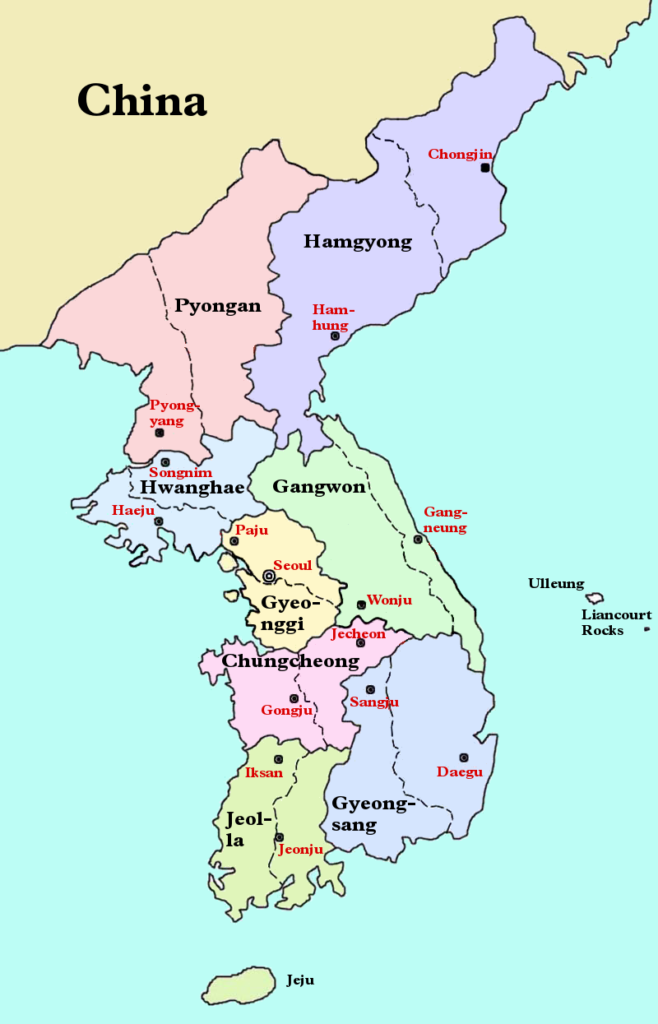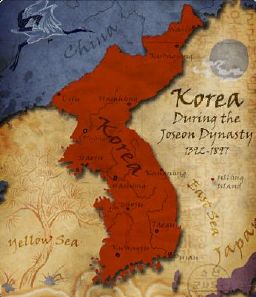The Eight Regional Traits of Korea
The Gwangju News reaches into its archives to bring you this August 2008 article by Prof. Shin Sang-soon (1922–2011) from his column, “The Korean Way.” The article describes the “official” characteristics of the Joseon Dynasty’s eight provinces. — Ed.
When a region, large or small, is long isolated from other regions by geographical features such as wide rivers or steep mountains, it is quite possible that a certain peculiar trait may develop that becomes unique to the residents of that particular region.
During the early period of the Yi Dynasty (1392–1910), Korea was already divided into eight administrative provinces, which remained the same for almost 500 years, until 1910 when the peninsula was colonized by Japan.
Area-wise, Korea (North and South combined) is 85,228 square miles, which is a little bigger than the U.S. state of Utah and a little smaller than the state of Minnesota. One might easily think of all Koreans as a whole, but dividing them into eight provincial regions might sound out of the ordinary. However, the entire population of Korea at the time of the Yi Dynasty (a.k.a. Joseon Dynasty) in 1392 is estimated to have been only about eight million (now 70 million for the North and South together).
Considering that mountainous areas comprise 70 percent of the total land area, one can easily conclude that the country was very sparsely populated, separated by uncrossable rivers and insurmountable mountains. Besides, the lack of modern means of communication like TVs, radios, and newspapers, and of modern means of transportation such as cars, ships, airplanes, and highways might certainly have rendered people inactive in exploring the outside world, confining them to their small hamlets. These may have given rise to the eight regional traits of Korea, well known among its people. During the early days of the Yi Dynasty, the founding king, Taejo, told his trusted courtier Jeong Do-jeon to describe the characteristics of the people of the eight provinces.

JEONG’S EIGHT-PROVINCE DESCRIPTIONS
Gyeonggi-do (경기도)
A beauty in the mirror.
[鏡中美人/경중미인]
Situated in the center of the centralized system of Korea, the people in Gyeonggi-do, in the vicinity of the capital, are known to have good social skills but are inaccessible, like a beauty in a mirror – they are only good to look at. They are looked upon as intellectual, and they value honor.
Chungcheong-do (충청도)
Clear wind and bright moon.
[淸風明月/청풍명월]
The people of Chungcheong Province are traditionally called yangban (양반, literati). They speak rather slowly and are regarded as high-minded and elegant, rather than competitive, like the leisurely flowing Geumgang River, which meanders through the province.
Jeolla-do (전라도)
Slender willow in the wind.
[風前細柳/풍후세류]
This original meaning was favorable to the Jeolla-do people. As Jeolla-do was the breadbasket of the country, the people there were noted for their warmth, kindhearted nature, and artistic sensitivity. But, later on, the meaning was twisted to mean that the people were feeble-willed like the slender willow twigs swaying to and fro in the wind. But the people of the province interpret it the other way round. That is, softness overcome stiffness (柔能制剛/유능제강). Gwangju was a part of Jeolla-do, and Gwangju citizens pride themselves on beating back the paratroopers in the struggle for democratization in May 1980.
Gyeongsang-do (경상도)
Fidelity like pine and bamboo.
[松竹大節/송축대절]
The ever-green pine and the straight bamboo are the symbols of fidelity and frankness. The people of the Gyeongsang area are noted for their roughness and strong nerve, being labeled as “stubborn.” There is an old saying that when three Gyeongsang-do people talk, they make the whole village noisy. They are often likened to big mountains and steep ranges (泰山峻嶺/태산준령).
Gangwon-do (강원도)
Old Buddha under a big rock.
[岩下老佛/암하노불]
In spite of its large area, Gangwon-do is very sparsely populated and the rare encounters with neighbors resulted in simplicity and honesty in their personality. Some also interpret it as connoting a person unworthy of note.
Hwanghae-do (황해도)
Throwing a stone into a spring wave.
[春波投石/춘파투석]
Hwanghae-do is located on the west coast just northwest of Seoul across the DMZ (Demilitarized Zone). Throughout its history, no noteworthy actions have been observed in this province. Jeong Do-jeon’s comment possibly meant a leisurely fisherman idling away, throwing stones into the waves in the spring, depicting a pastoral, provincial scene.
Pyeongan-do (평안도)
Fierce tiger in the wood.
[山林猛虎/산림맹호]
This comment depicts the fierce nature of the Pyeongan-do residents. They were in frequent contact with the Chinese across the border of the Yalu River, either in a friendly or a rivalry situation. There is a saying that when arguing with a Pyeongan-do person, you must watch out, because he will strike you with his head like a bolt of lightning.
Hamgyeong-do (함경도)
Coming to the last province, Hamgyeong-do, Jeong Do-jeon refrained from making a comment. Urged by the king several times, Jeong had to open his mouth, telling the king that the residents there were like dogs fighting in a muddy field (泥田鬪狗/이전투구), meaning that the people were very tenacious. Hamgyeong-do was the province where the king was born and raised. The comment denotes a negative image, and the king’s displeasure was apparent. The quick-witted Jeong took notice of the king’s facial color change and added, “But they are like an ox tilling a stony field” (石田耕牛/석전경우), meaning perseverance overcomes hardship. The king was pleased and awarded Jeong a prize.
Some comments on the characteristics of certain residents in long-isolated ancient regions could still hold, but as mentioned at the beginning, modern means of communication and transportation have erased distance barriers, bringing separated neighbors closer together, which makes differentiation of traits in this country today more difficult.
Postscript
An interesting point is how the names of Joseon’s pal-do (판도, 八道, 8 provinces) were created. In most cases, the names of the two most prominent towns in the province were incorporated, using the first syllable (i.e., Chinese character) of each and adding “-do” for “province.” Therefore, Chungcheong-do was derived from Chungju and Cheongju (Chung+Cheong), the two main population areas at the time. Jeolla-do is from Jeonju and Naju (phonological change from Raju/라주). Gyeongsang-do is from Gyeongju and Sangju. Gangwon-do is derived from Gangneung and Wonju. Gyeonggi-do is the exception, as it often is: Gyeonggi means “capital area.” If you are wondering about Jeju-do, it was not a province in Joseon times; it was part of Jeolla-do.
In the North, Hwanghae-do derived its name from Hwangju and Haeju. Pyeongan-do comes from Pyeongyang and Anju. Hamgyeong-do is from Hamheung and Gyeongseong. An earlier name for the province was Hamgil-do, from Hamheung and Gilju. As has occurred in South Korea, the provinces of North Korea have been divided up so that each country now has nine provinces.
Today, Jeong Do-jeon might have very different descriptions of the people of the provinces for the king than he did six centuries ago.
Arranged by David Shaffer







